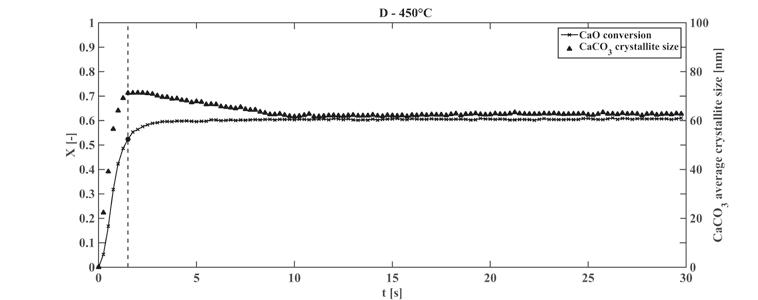
2 minute read
Ambiente
CO² capture using CaO-based sorbents: microstructure evolution and reaction kinetics
A promising technology to capture CO emissions from combustion and gasification power plants at high temperature involves the utilization of CaO based porous solid sorbents. e advantages of these materials include a high theoretical capture capacity (0.78 kg of CO per kg of CaO) and a high CO capture rate at high temperatures. e CaO carbonation kinetics is related to the evolution of the sorbent microstructure, namely of the textural properties and of the CaO/CaCO crystallite size. Using an innovative approach, based on a capillary flow-cell and on time-resolved in-situ synchrotron radiation XRPD, the CaCO crystallite size and the CaO conversion were simultaneously computed even at short times (Figure 1). Very high CaO conversion rates (0.28 s-1) were obtained, thanks to the capillary reactor by which external mass transfer was minimized. e transition between the first fast stage of the CaO carbonation and the product-layer diffusion controlled stage was interpreted through the concept of critical CaCO crystallite size; such quantity was defined as the local maximum in the CaCO crystallite size curves over time and marks the transition between the two reaction stages. An equation was developed to compute the active surface area from the critical CaCO crystallite size measurements; the active specific surface area is related to the surface area effectively utilized to form carbonate islands over the CaO particle internal surface. Intrinsic reaction rate parameters were calculated combining the active surface area with the conversion rate data (Figure 2), obtaining a zero-activation energy. e estimates of the active specific surface area, the decrease of the active surface area and the increase of the CaCO crystallite size with the reaction temperature provide quantitative support to a description of the CaO carbonation, in which the CaCO is not uniformly distributed over the particle internal surface.
Advertisement
Fig 1: CaCO crystallite size and CaO conversion versus time (carbonation at 450°C).
Fig 2: CaO conversion rate vs CaO specific surface area at the beginning of carbonation. Solid line represents the zero-activation energy behavior. Ambiente Environment

DII research group CO2 Capture and Multiphase CFD
Matteo Strumendo matteo.strumendo@unipd.it Phone: +39 049 8275464
Collaborator Alberto Benedetti
www.dii.unipd.it
This investigation was conducted in collaboration with Prof. C. Segre (Illinois Institute of Technology), Prof. G. Salviulo (University of Padova), Dr. Zorzi (University of Padova), Dr. G.J. Halder (Argonne National Laboratory) and Dr. A. Yakovenko (Argonne National Laboratory). Experiments were performed at the Advanced Photon Source of the Argonne National Laboratory. Additional information on this work can be found in: A. Biasin, C.U. Segre, G. Salviulo, F. Zorzi, M. Strumendo, CES, 2015, 127, 13-24; A. Biasin, C.U. Segre, M. Strumendo, Crystal Growth and Design, 2015,15, 5188-5201.
Main research topics: • CO2 Capture and Utilization • CO2 solid sorbents synthesis and characterization • Thermogravimetric analysis of gas-solid reaction kinetics • In-situ microstructure analysis of non-catalytic gas-solid reactions • Computational Fluid Dynamics of single phase and gas-solid systems • Population balances







